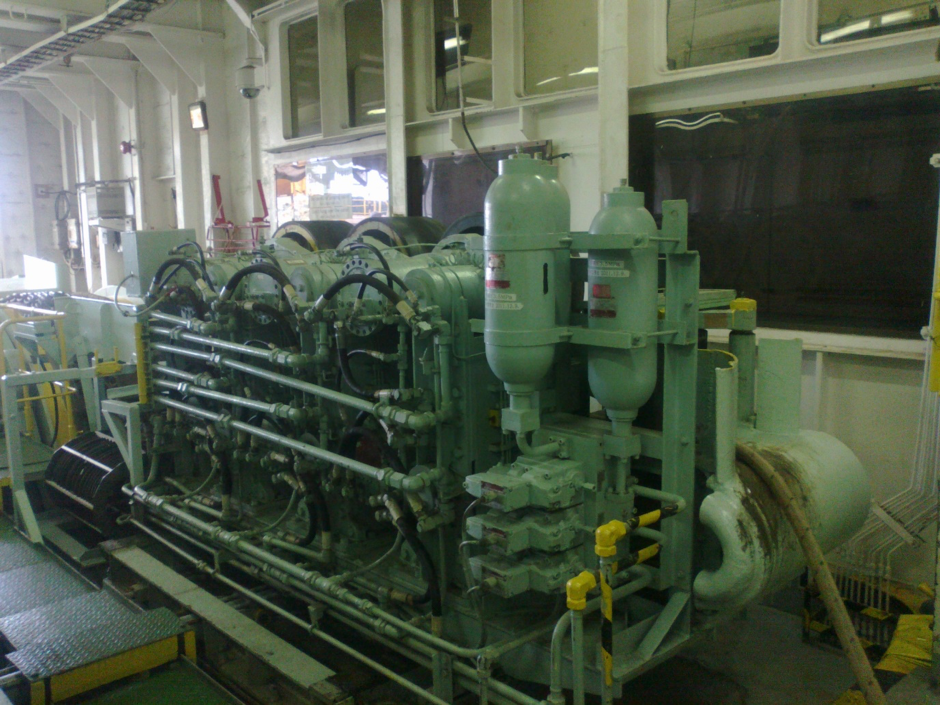The KDDI Pacific Link (KPL) arrived in Malakal harbour in the early morning of September 1st 2017.
KPL was originally built in 1993 for oil rig work and converted to a cable ship in 1998. She is a powerful vessel, 109 metres long and twenty metres wide, with two azimuth thrusters and three bow thrusters, able to maintain position to the metre in heavy seas through a Dynamic Positioning System (DPS). The DPS has two reference points – one at the ship’s centre of gravity and another at the stern, fifty metres away, the point where cable laying operations are focused.
On the bridge, she has both bow facing (for steaming) and stern facing (for cable lay operations) controls. Alongside the stern facing control desk, where the captain controls the ship, a specialist submarine cable engineer monitors all aspects of the cable laying operations.
The 200 kilometres of cable that KPL will lay out from the Pre-Lay Shore End (PLSE) that extends 7 km out from Ngeremlengui, through the West Passage, hardly taxes the capacity of one of her two huge main cable tanks.
The total lightweight cable capacity of the KPL is over 5,000 kilometres!
There is one repeater on the BSCC cable that is going to be laid over the next week. This is the very one:
There is already another repeater on the ocean floor, on a stub cable connected to a branching unit on the main SEA-US cable linking Philippines and Indonesia to Guam, Hawaii and the east coast of USA.
From the cable tank, cable is fed along a tray on the main work deck towards the stern.
BSCC Project Management Unit engineers Martin Blakely and Richard Misech conducted a tour of the ship for Minister of Finance Elbuchel Sadang, members of the BSCC Board and press. Martin had just spent over a fortnight at sea on KPL and was very generous with what could have otherwise been valuable shore time. The crew was back at sea after only a day ashore.
KPL is capable of maintaining cable lay operations at up to 10 kilometres per hour. That means the cable has to be pulled out of the tank and over the stern at maybe 11 kilometres per hour, since the cable is laid slack. And even lightweight cable is heavy. Banks of tires are used in a Linear Cable Engine (LCE) to keep the cable moving at the required speed.
The whole time the cable is being laid, it is being tested. Before arriving in Palau, KPL laid the Yap spur to SEA-US, and also recovered the BSCC stub connected to SEA-US. This stub was buoyed off, to await KPL’s return in 4 or 5 days. The crew have been working very hard and achieved a two day saving on the schedule already. Here are some of KPL’s fifty-seven crew and cable specialists:
Alongside the LCE are a pair of massive Drum Cable Engines.
These are used when, for specialised operations such as repeater deployment, cable is wound around large drums, from which it can be uncoiled.
The cable is finally deployed at the stern, to make its way to the sea floor, as deep as five thousand metres for the BSCC network.
There is other equipment aboard KPL that won’t be required for our work, but is used in some cable lay operations. There is an ROV (remotely operated vehicle) that can deploy its robot arms and tools where divers cannot go. There is also a water-jet plough, capable of burying cable up to 3 metres deep in sandy conditions.
The BSCC cable is not buried. The PLSE is protected by articulated steel pipe in the inshore section to the beach bulkhead.
Immediately after leaving Malakal on 2nd September, KPL took station outside the West Passage to recover the lead rope and chain attached to the PLSE. A sinister looking grapnel was deployed.
The PLSE was jointed to the main spur cable, and KPL started laying the 200 kilometres out to SEA-US.
Extensive supplier, purchaser and BSCC customer testing will start in another nine days. We remain on track for December Ready for Service (RFS).










